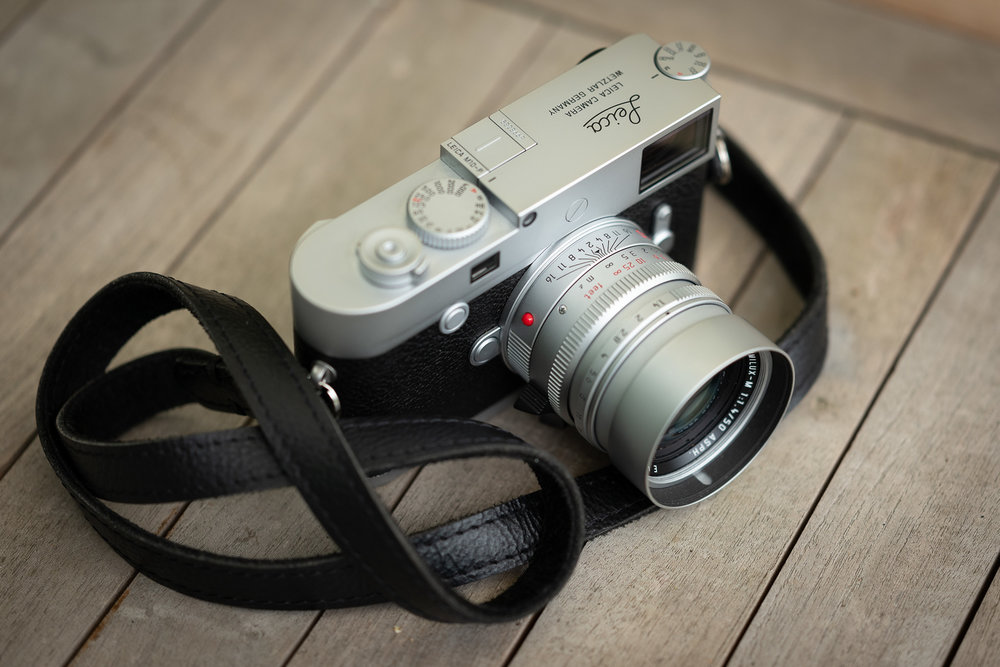
Introduction
Leica have been creating incremental updates of their digital M cameras since the M8.2 added a sapphire crystal rear display, different framelines and a quieter shutter in 2009. Of course, there have also been many limited-edition cameras, but they haven’t normally had any technical changes.
The M9 existed in four basic models:
- M9 in 2009
- M9-P in 2011 — this established the ‘P’ version with a sapphire glass LCD, a screw as a replacement for the red dot and with the Classic Leica logo on the top plate.
- M Monochrom in 2012 which was similar to the M9-P but with a revolutionary monochrome sensor
- M-E was a reduced cost model which was missing the frameline selector and the USB port and a dark grey body.
The M(240) added another variant
- M type (240) announced at Photokina in September 2012 (at the same time as the M-E) but not delivered until 2013.
- M-P type (240) announced in 2014 had a larger screw to replace the red dot and a larger buffer. No sapphire glass screen as the gorilla glass of the basic model was sufficient. Once again it had the classic Leica logo on the top plate.
- The M type (262) arrived in December 2015 and was the reduced cost model (the equivalent of the M-E). It had a smaller buffer and an aluminium top plate to reduce the weight.
- M-D type(262) was inspired by the success of a limited edition camera (the M edition 60 from 2014) without a rear LCD the camera had no rear screen (replaced by an ISO dial).
- M Monochrom type(246) was released in April 2015 with a black and white sensor without the Bayer filter array.

The M10 was released in January 2017 and has proved to be a real success: In a sense, it was ‘back to basics’. The camera has a body the same thickness as an M7 and has abandoned video (nobody seemed to notice) and much more controversially the level gauge of the M240. 18 months on (as has now become traditional) it’s time for the first variant, and here is the M10-P.
In the past, I haven’t written about the ‘P’ cameras as they have only amounted to cosmetic changes (and I don’t usually get sent a camera to test). The M10-P is rather a different thing, there are some serious changes from the M10, some of which are going to make a lot of people very happy!
Generally speaking, I have a camera for several months, often (by coincidence) coinciding with one of our trips abroad. In this case, I’ve had a camera only for a week or two, and we have been firmly embedded on the Norfolk and Suffolk border.
So I decided to take pictures of the world around me,
My role with Leica is to test the cameras, not to write reviews of them, and it’s important to understand that this article is not intended to be a critical review. If I find something wrong with a camera, then I tell Leica. Having said that, this article is my work, nobody has suggested what I should write, and I certainly wouldn’t say anything that I don’t believe to be the case or omit anything that seemed to be an issue.

Overview
Although the M10-P has identical firmware to the M10 and has the same sensor (without any tweaks or changes), there are three radical technical changes to the camera:
- The Touch Screen
- The Return of the Level Gauge
- A Much (MUCH) quieter shutter.
I’ll deal with each of these different features in the rest of this article.

Body and Design
I’ve only handled the chrome camera, but the design changes are consistent with the M9 and M(240) ‘P’ models with the classic Leica logo on the top plate and an enlarged screw in place of the red dot on the front of the camera. No need for a sapphire glass LCD cover as the existing M10 screen is scratch resistant to a high degree (mine is unscratched after two years without protection). As I understand it Leica have diverted from tradition a little in that the black camera is black chrome rather than black paint; I imagine this will disappoint a few purists who like their cameras brassy!

The Touch Screen
This is a first for the M cameras and it’s been implemented conservatively but really nicely.
Playback
This works just as you would expect, Swiping moves between pictures, pinching zooms in and out and the zoomed in point can be moved around as you would expect. Just like the M10, it has the useful ability to move between images when zoomed in (by holding down the play button and turning the thumbwheel.
Menu and Status Screen
When you press the centre button of the rocker switch you get the standard status screen, which looks just the same as in the M10. Touching some of the controls brings up the relevant menu item directly:
Exposure compensation – this brings up the normal exposure compensation dial which is also touch enabled
- ISO – logically and correctly this only works when M is chosen on the ISO dial on the top-plate. This changes the M setting for ISO in the menu. less consistently the ISO dial is not touch enabled.
- White Balance – tapping on the white balance symbol brings up the WB menu (again, this is not touch enabled)
- File Format (DNG / jpg / both)- I’m not sure that one would often want to change that from here, but this is also touch enabled
Generally speaking, the Menu itself is not touch enabled.
When shooting in Live View
When in Live View, you can touch the screen at any point, and then when turning the focus ring of any M lenses the camera will zoom in at this point. If you have spot metering enabled then the point is represented by a circle, with other metering types it is represented by a cross. Obviously to make this work you must have Focus Aid set to Automatic in the Capture Assistants section of the camera menu.
If you don’t want the focus aid set to Manual (as I prefer) then it’s still great to be able to move the zoom/spot metering mark around with your finger before zooming in by touching the button on the front of the camera (or the thumb dial).
I think this option will be particularly popular with tripod and landscape photographers, it’s well thought out and works beautifully (I wish that Leica would implement the manual version of this functionality with the SL and CL operation when using M lenses).

The Return of the Level Gauge
I never did see the point of a level gauge, it seems to me that if there is a horizon you don’t need it, and if there isn’t then what ‘feels right’ is what you want. However, it seems that I’m in the minority here and lots of people really missed it in the M10. There was much talk about it being implemented in firmware, but in fact, that isn’t possible as the hardware is not present.
Leica have listened to the complaints and the hardware has been added to the M10-P and the level gauge is back. I’m sure that many people will be very happy (and I can turn it off!).

The Quieter Shutter
The shutter on the M10 is very quiet — and some might have thought that no improvement was needed. The shutter on the M10-P, however, is a real revelation, although the basic sound is the same, it’s been damped to make it sound much quieter. When I first heard it I felt as if I had earplugs in! The fact that the sequence of sound is the same suggests that this really is a damping exercise rather than a new shutter, but however, they have managed it this will be a game changer for some Leica users.
I’ve attached a recording with the M10 and M10-P at 1/15th 1/60th 1/250th and 1/1000th second. The cameras were placed next to each other, equidistant from the microphone. I think it speaks for itself!

Conclusion
As you can see, the M10-P is not just a pretty face; in addition to the expected M10-P cosmetic changes, it represents some real advantages over the M10.
At the time of writing, I’m not sure how big the price differential between the two cameras will be, but I imagine that for those photographers who have been waiting for the ‘P’ version before replacing their M(240) cameras it will be worth every penny.
For the rest of us who have already bought their M10 the question of whether or not to upgrade is not so simple. I’ve really enjoyed using the touch screen and the quieter shutter makes one feel a great deal less obtrusive when shooting in quiet environments (not that I ever felt the M10 shutter noise was disturbing subjects!).
Many people thought that the M10 was the ultimate M camera and that Leica would find it hard to improve on it without compromising its core values. I think they should be congratulated on improving the camera significantly on 3 different levels without compromising it in any sense.
© Jonathan Slack, August 2018








_________________

I don’t know How I missed this back in August. I always read Jonathan’s articles for the beauty of the photos alone, and this one is no exception. Sheer delight.
A better than average upgrade for the latest P version. Should make for happier ownership. An interesting report, Jonathan. Thank you.
Were I to pick three things to change on the M10, these three things would have been nowhere on my list. Weird Leica, as usual.
Interesting. What three things are on your list?
It is always great to read Mr.Slack’s articles, I am glad he has written this in such a timely manner. Thank you for continuing our Leica education .